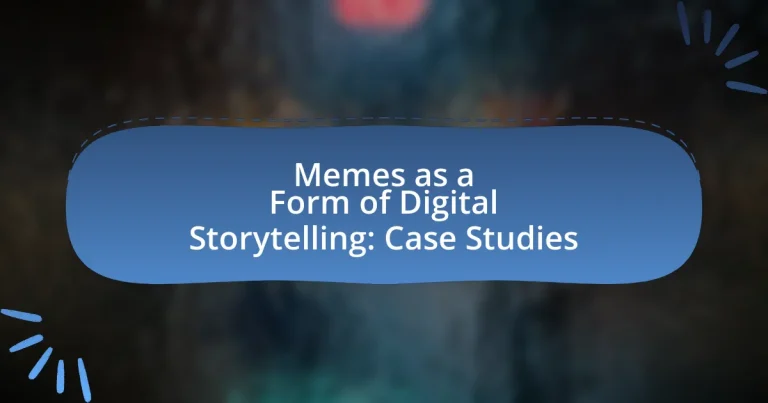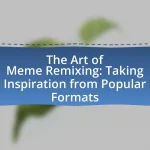Memes are defined as humorous images, videos, or text that are widely shared and modified online, serving as a modern form of digital storytelling. This article explores how memes function as effective storytelling tools by conveying complex narratives and emotions through visual and textual elements. It examines various types of memes, including image macros and video memes, and highlights notable case studies such as the “Distracted Boyfriend” and “Woman Yelling at a Cat” memes, illustrating their cultural relevance and impact on societal discourse. Additionally, the article discusses best practices for creating relatable and engaging memes that resonate with audiences.
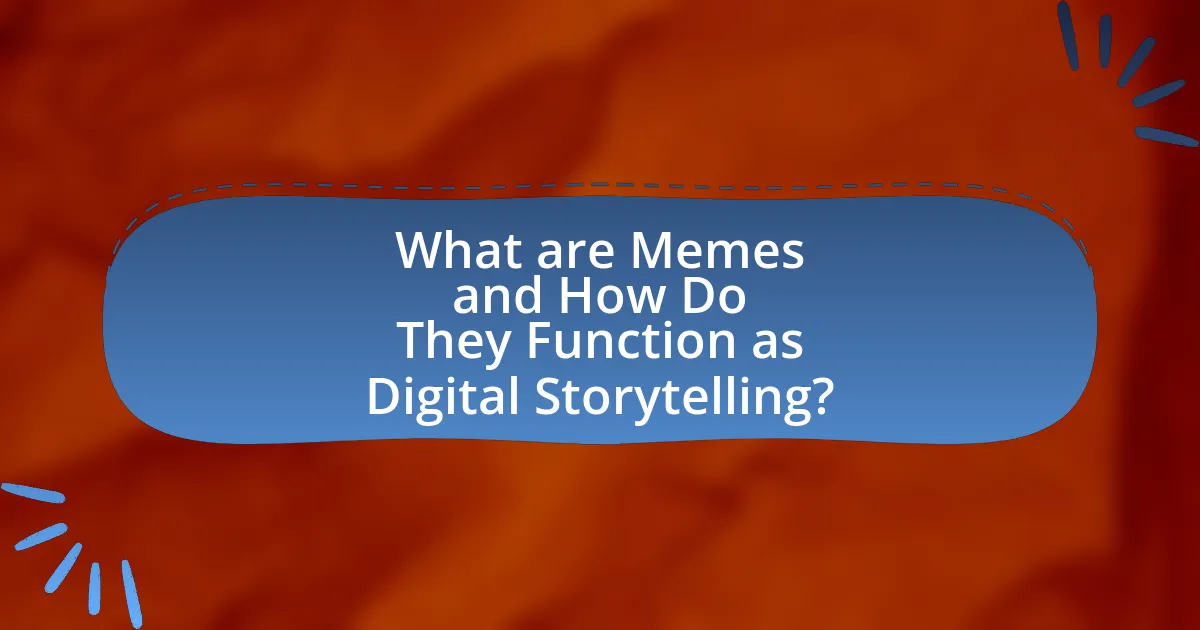
What are Memes and How Do They Function as Digital Storytelling?
Memes are humorous images, videos, or text that are widely shared and modified across the internet, often conveying cultural or social commentary. They function as digital storytelling by encapsulating complex ideas, emotions, or narratives in a concise and relatable format, allowing for rapid dissemination and engagement among audiences. For instance, the “Distracted Boyfriend” meme illustrates the concept of shifting attention in relationships, effectively communicating a narrative through visual humor. This format enables users to connect with shared experiences, fostering community and dialogue around specific themes or issues.
How do memes convey narratives in a digital context?
Memes convey narratives in a digital context by utilizing visual and textual elements to communicate complex ideas and emotions succinctly. These digital artifacts often rely on cultural references, humor, and irony to engage audiences, allowing for rapid dissemination of shared experiences or commentary on societal issues. For instance, the “Distracted Boyfriend” meme encapsulates a narrative of choice and temptation, illustrating relational dynamics in a relatable manner. This effectiveness is supported by the fact that memes can be easily modified and remixed, enabling users to adapt narratives to fit various contexts, thus enhancing their relevance and impact in digital communication.
What elements make memes effective storytelling tools?
Memes are effective storytelling tools due to their ability to convey complex ideas quickly through visual and textual elements. The combination of relatable imagery, concise text, and humor allows memes to engage audiences and evoke emotional responses. Research indicates that memes can enhance memory retention and understanding, as they often simplify narratives into digestible formats. For instance, a study published in the journal “Computers in Human Behavior” found that visual aids, like memes, significantly improve information recall compared to text-only formats. This effectiveness stems from their shareability and cultural relevance, enabling them to spread rapidly and resonate with diverse audiences.
How do visual and textual components work together in memes?
Visual and textual components in memes work together to create a cohesive message that enhances humor or commentary. The image serves as a visual anchor, often conveying emotions or context that the text alone cannot express. For instance, a popular meme format might feature a well-known image paired with a caption that adds a humorous twist or social critique, effectively combining visual cues with linguistic elements to engage the audience. Research indicates that this synergy allows for rapid comprehension and emotional resonance, as the brain processes images faster than text, making the overall message more impactful.
Why are memes considered a modern form of storytelling?
Memes are considered a modern form of storytelling because they convey narratives, emotions, and cultural commentary through concise visual and textual elements. This format allows for rapid dissemination and engagement, enabling users to share complex ideas and social critiques in an easily digestible manner. Research indicates that memes can encapsulate societal trends and collective experiences, functioning similarly to traditional storytelling by reflecting shared values and humor within a community. For example, the viral meme “Distracted Boyfriend” illustrates relationship dynamics and societal expectations, effectively communicating a narrative that resonates with a wide audience.
What cultural factors contribute to the popularity of memes?
Cultural factors that contribute to the popularity of memes include shared humor, social commentary, and the rapid dissemination of information through digital platforms. Shared humor allows individuals to connect over relatable experiences, making memes a form of collective expression. Social commentary embedded in memes often addresses current events or societal issues, resonating with audiences and encouraging engagement. The rapid dissemination of memes via social media platforms, such as Twitter and Instagram, facilitates their spread, allowing them to reach a wide audience quickly. This combination of relatability, relevance, and accessibility reinforces the popularity of memes in contemporary culture.
How do memes reflect societal values and issues?
Memes reflect societal values and issues by encapsulating cultural sentiments, humor, and critiques in a concise format. They serve as a mirror to contemporary social dynamics, often highlighting political, economic, and social concerns. For instance, during the COVID-19 pandemic, memes addressing public health guidelines and government responses proliferated, illustrating collective anxieties and frustrations. Research by the Pew Research Center indicates that 55% of U.S. adults reported encountering memes related to social issues, demonstrating their role in shaping public discourse. Thus, memes not only entertain but also provoke thought and discussion about pressing societal matters.
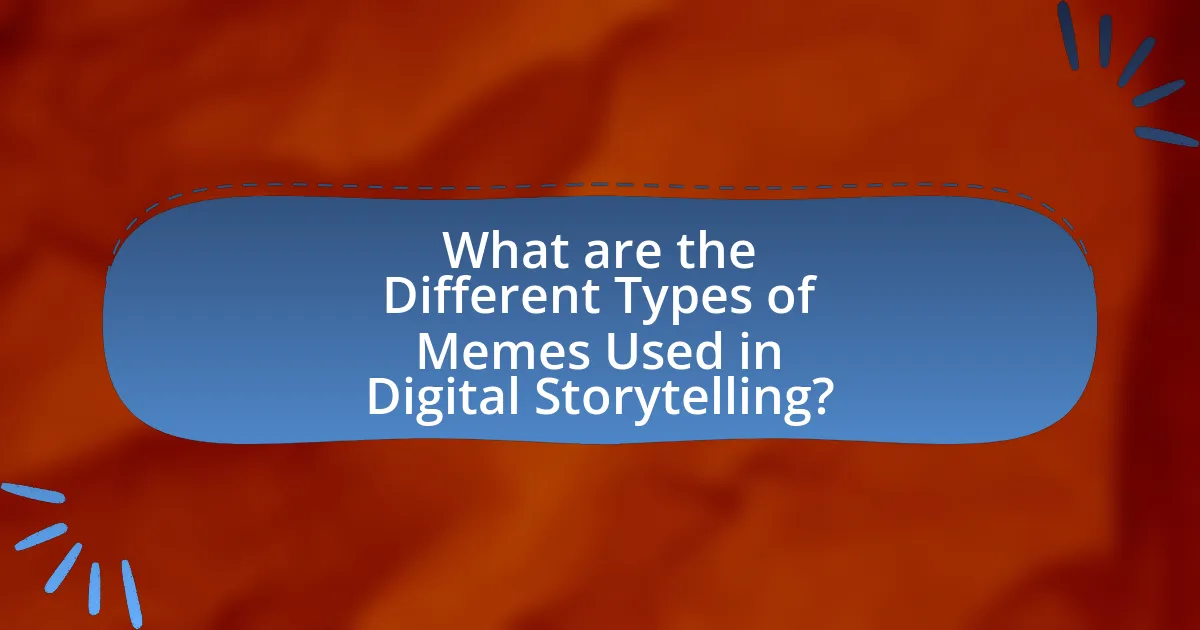
What are the Different Types of Memes Used in Digital Storytelling?
Different types of memes used in digital storytelling include image macros, GIFs, video memes, and text-based memes. Image macros typically feature a humorous image with overlaid text, effectively conveying a narrative or emotion. GIFs serve as short, looping animations that can encapsulate moments or reactions, enhancing storytelling through visual engagement. Video memes often remix popular video clips with added commentary or humor, allowing for a dynamic narrative format. Text-based memes, such as copypasta or reaction text, utilize written content to convey messages or emotions succinctly. Each type of meme contributes uniquely to digital storytelling by engaging audiences and facilitating the sharing of ideas and emotions in a relatable manner.
How do image-based memes differ from video memes?
Image-based memes differ from video memes primarily in their format and engagement style. Image-based memes typically consist of a single static image paired with text, allowing for quick consumption and immediate humor or commentary. In contrast, video memes incorporate moving visuals and audio, which can convey more complex narratives or emotions over a longer duration. Research indicates that image-based memes often rely on visual puns or cultural references that can be understood rapidly, while video memes can utilize timing, sound effects, and editing techniques to enhance comedic or dramatic impact, thus engaging viewers in a more immersive experience.
What are the characteristics of image-based memes?
Image-based memes are characterized by their combination of visual elements and text to convey humor, commentary, or cultural references. These memes typically feature a recognizable image, often sourced from popular culture, paired with concise, impactful text that enhances the meaning or humor of the image. The use of relatable themes and emotions allows image-based memes to resonate with a wide audience, facilitating rapid sharing and engagement across social media platforms. Additionally, the format often employs irony, absurdity, or exaggeration, which contributes to their viral nature and cultural relevance.
How do video memes enhance storytelling compared to static images?
Video memes enhance storytelling compared to static images by incorporating motion, sound, and timing, which create a more immersive narrative experience. The dynamic nature of video allows for the expression of emotions and actions that static images cannot convey, making the storytelling more engaging. For instance, a video meme can utilize humor, pacing, and audio cues to build context and evoke reactions, which are essential elements in effective storytelling. Research indicates that multimedia content, including video, increases viewer retention and emotional connection, as evidenced by studies showing that people remember 95% of a message when it is delivered through video compared to only 10% when read in text form. This demonstrates that video memes are a powerful tool for enhancing storytelling by leveraging sensory engagement and emotional resonance.
What role do formats like GIFs and image macros play in meme storytelling?
Formats like GIFs and image macros serve as essential tools in meme storytelling by providing visual shorthand that conveys emotions, reactions, and narratives quickly and effectively. These formats allow creators to encapsulate complex ideas or cultural references in a single, easily shareable image or animation, enhancing the communicative power of memes. For instance, a GIF can capture a fleeting moment of humor or emotion, while an image macro often combines a relatable image with text to create a punchline or commentary on social issues. This combination of visual and textual elements facilitates immediate understanding and engagement, making memes a potent medium for storytelling in digital culture.
How do GIFs capture moments and emotions in storytelling?
GIFs capture moments and emotions in storytelling by providing a concise visual representation that conveys feelings and actions quickly. Their looping nature allows for the repetition of key moments, enhancing emotional impact and engagement. Research indicates that visual stimuli, such as GIFs, can evoke stronger emotional responses compared to static images or text, as they combine motion with relatable content. For instance, a study published in the journal “Computers in Human Behavior” found that animated visuals significantly increase viewer retention and emotional connection, making GIFs an effective tool for storytelling in digital media.
What makes image macros a popular choice for quick narratives?
Image macros are a popular choice for quick narratives due to their ability to convey complex ideas succinctly through a combination of visuals and text. This format leverages the immediacy of images to capture attention while the accompanying text provides context or humor, facilitating rapid understanding. Research indicates that visual information is processed 60,000 times faster than text, making image macros particularly effective for quick communication. Additionally, their shareability on social media platforms enhances their reach, allowing narratives to spread quickly and engage diverse audiences.
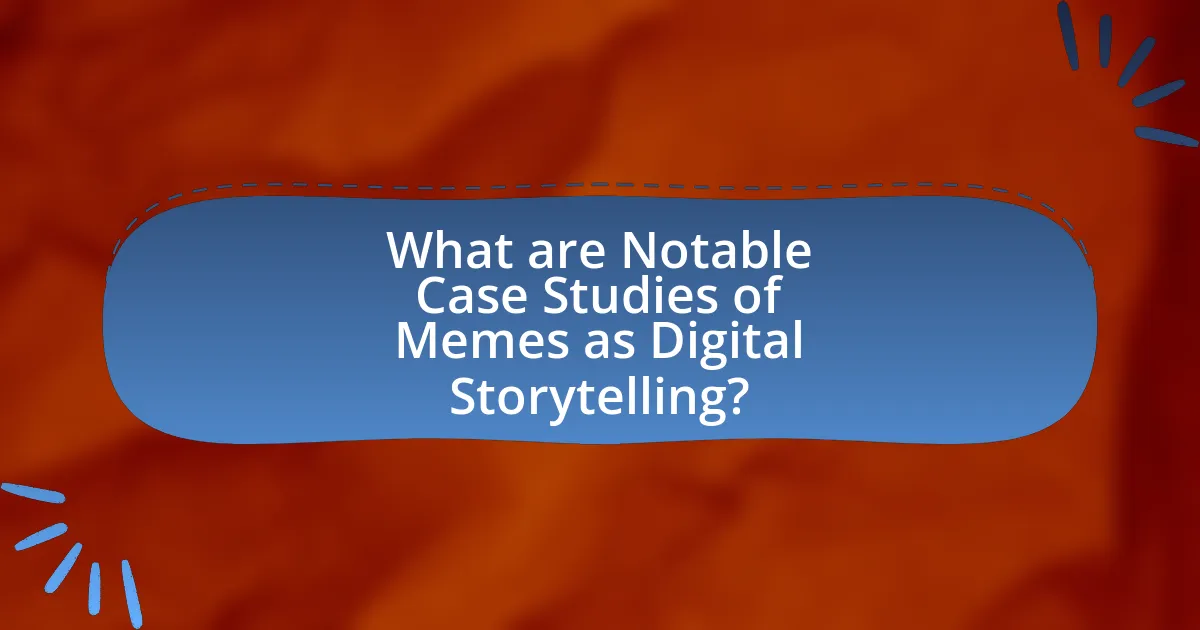
What are Notable Case Studies of Memes as Digital Storytelling?
Notable case studies of memes as digital storytelling include the “Distracted Boyfriend” meme, which illustrates the concept of shifting attention and priorities in relationships, effectively conveying complex social commentary through a simple image. Another significant example is the “Woman Yelling at a Cat” meme, which juxtaposes emotional expressions with absurdity, allowing users to narrate personal experiences or societal observations humorously. Additionally, the “Is This a Pigeon?” meme has been utilized to critique misunderstandings in various contexts, showcasing how memes can encapsulate and communicate intricate ideas succinctly. These case studies demonstrate how memes serve as a modern narrative tool, enabling users to share stories and perspectives in a relatable and engaging manner.
How did the “Distracted Boyfriend” meme tell a relatable story?
The “Distracted Boyfriend” meme tells a relatable story by visually representing the common human experience of temptation and distraction in relationships. The image depicts a man looking at another woman while his girlfriend looks on disapprovingly, symbolizing the struggle between commitment and desire. This scenario resonates with many individuals who have faced similar dilemmas in their personal lives, making it a universal theme. The meme’s widespread use across various contexts, from romantic relationships to professional choices, further emphasizes its relatability, as it captures the essence of conflicting priorities and the allure of the new over the familiar.
What elements contributed to its viral success?
The elements that contributed to its viral success include relatability, humor, and shareability. Relatability allows audiences to connect with the content on a personal level, making them more likely to share it. Humor engages viewers, creating an emotional response that encourages sharing. Shareability is enhanced by the format and timing of the meme, which often aligns with current events or trends, maximizing its reach. For instance, memes that reference popular culture or trending topics tend to spread rapidly across social media platforms, as evidenced by the rapid dissemination of the “Distracted Boyfriend” meme, which gained millions of shares within days of its creation.
How did audiences interpret the narrative behind the meme?
Audiences interpreted the narrative behind the meme as a reflection of shared cultural experiences and social commentary. This interpretation often stems from the meme’s ability to encapsulate complex emotions or societal issues in a humorous or relatable format, allowing viewers to connect with the content on a personal level. For instance, memes that address current events or popular trends often resonate with audiences because they provide a concise and engaging way to express collective sentiments, as evidenced by the widespread sharing of memes during significant political events or social movements.
What impact did the “Woman Yelling at a Cat” meme have on digital storytelling?
The “Woman Yelling at a Cat” meme significantly influenced digital storytelling by exemplifying how visual humor can convey complex narratives and emotions succinctly. This meme combines a still image of a woman yelling with a contrasting image of a confused cat, allowing users to create relatable and humorous scenarios that resonate widely across social media platforms. The meme’s versatility has led to its use in various contexts, illustrating personal experiences, societal issues, and cultural commentary, thereby enhancing engagement and relatability in digital narratives. Its widespread adoption demonstrates the power of memes to encapsulate and communicate stories quickly, making them a vital tool in contemporary digital storytelling.
How did this meme evolve over time in its narrative context?
This meme evolved over time by adapting its narrative context to reflect changing social and cultural dynamics. Initially, the meme conveyed a straightforward message or joke, often rooted in a specific event or trend. As it gained popularity, users began to remix and reinterpret the meme, infusing it with new meanings that resonated with diverse audiences. For example, the “Distracted Boyfriend” meme started as a humorous depiction of infidelity but evolved to represent various forms of distraction and shifting priorities in contemporary life. This adaptability illustrates how memes serve as a form of digital storytelling, allowing for a collective narrative that evolves with societal changes and user creativity.
What cultural references did it tap into for storytelling?
The storytelling in memes taps into various cultural references, including internet culture, popular media, and social commentary. Memes often utilize recognizable images, phrases, or tropes from films, television shows, and viral trends to convey humor or critique societal norms. For instance, the “Distracted Boyfriend” meme references a stock photo that symbolizes the conflict between desire and commitment, resonating with audiences familiar with relationship dynamics. Additionally, memes frequently draw on historical events or figures, such as the “This Is Fine” dog, which reflects societal reactions to crises, illustrating the absurdity of denial in the face of disaster. These cultural references enhance relatability and engagement, making the storytelling more impactful.
What lessons can be learned from these case studies for effective meme storytelling?
Effective meme storytelling can be enhanced by focusing on relatability, cultural context, and emotional resonance. Case studies demonstrate that memes that resonate with the audience’s experiences or emotions tend to be shared more widely, as seen in viral memes that reflect current social issues or trends. Additionally, understanding the cultural references and humor that appeal to specific demographics is crucial; for instance, memes that incorporate popular culture or internet trends often achieve greater engagement. Furthermore, successful memes often employ a clear narrative structure, allowing viewers to quickly grasp the message, which is supported by the fact that concise and visually engaging content captures attention more effectively.
How can creators leverage humor and relatability in their memes?
Creators can leverage humor and relatability in their memes by incorporating everyday experiences and emotions that resonate with their audience. By using common scenarios, shared frustrations, or cultural references, creators can evoke laughter and connection, making the content more engaging. For example, memes that depict relatable situations, such as the struggles of working from home or the challenges of modern relationships, often gain traction because they reflect the collective experiences of many individuals. Research indicates that humor enhances memory retention and sharing behavior, as seen in a study published in the Journal of Marketing Research, which found that humorous content is more likely to be shared on social media platforms. This demonstrates that when creators effectively blend humor with relatable themes, they not only entertain but also foster a sense of community among viewers.
What best practices should be followed when crafting memes for storytelling?
When crafting memes for storytelling, it is essential to ensure clarity and relatability. Memes should convey a clear message or narrative that resonates with the audience, utilizing familiar cultural references or humor to enhance engagement. Research indicates that memes that incorporate visual elements with concise text are more effective in communicating ideas quickly, as they leverage the brain’s ability to process images faster than text (M. A. H. Alhabash et al., 2017, “The Role of Memes in Digital Communication”). Additionally, maintaining a consistent tone and style throughout the meme series helps build a cohesive narrative, making it easier for the audience to follow the story.
